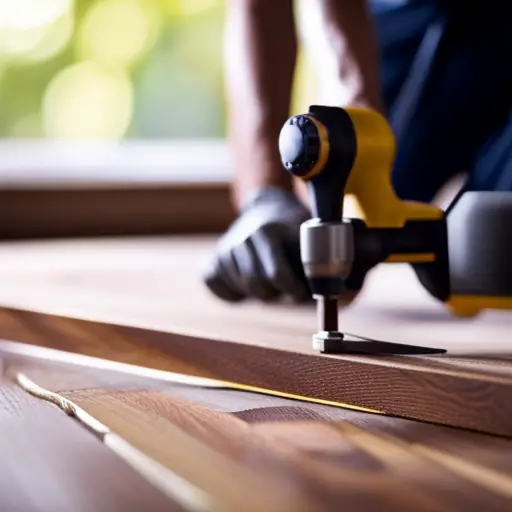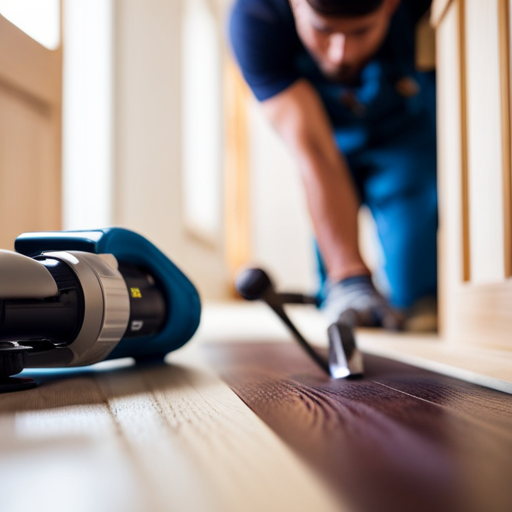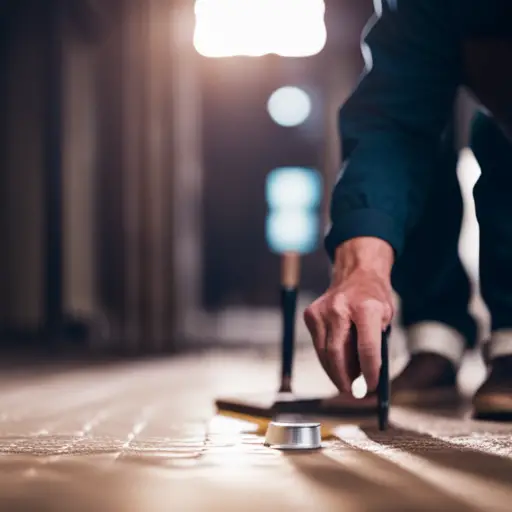The Essentials of Subfloor Preparation

The foundation of any successful flooring installation lies in the meticulous preparation of the subfloor. To achieve a durable and flawless result, a thorough assessment of the subfloor, effective moisture mitigation, precise leveling techniques, meticulous repair of any damage, and expert subfloor priming are essential.
This article will delve into the essential steps and techniques required for proper subfloor preparation to ensure a successful and long-lasting flooring installation.
Subfloor Assessment
The first step in subfloor preparation is to conduct a thorough assessment of the subfloor’s condition, identifying any imperfections or structural issues that may affect the installation of new flooring.
One crucial aspect to examine during this assessment is subfloor moisture. Excess moisture can lead to numerous problems, including mold growth, warping of wood materials, and adhesive failure. Therefore, it is essential to use a moisture meter to determine the moisture content of the subfloor.
Additionally, proper installation of the subfloor is paramount. This involves checking for levelness and flatness, as any deviations can result in an uneven final floor surface and potential damage to the new flooring material.
Furthermore, it is important to inspect for any signs of rot, decay, or pest damage, as these issues can compromise the structural integrity of the subfloor.
Moisture Mitigation
Assessing subfloor moisture content is crucial for ensuring a successful flooring installation. The next step in subfloor preparation involves addressing moisture mitigation. Waterproofing methods and sealing techniques are essential for preventing moisture-related issues such as warping, mold, and mildew.
Before proceeding with any moisture mitigation measures, it is imperative to conduct thorough moisture testing to determine the extent of the issue. Moisture barriers, such as specialized underlayments or coatings, can be applied to the subfloor to prevent moisture from seeping into the flooring material. These barriers act as a protective layer, safeguarding the flooring from potential damage caused by moisture.
Sealing techniques, including the use of moisture-resistant sealants, can also be employed to prevent moisture infiltration. It is important to note that different flooring materials may require specific waterproofing methods tailored to their unique characteristics.
Leveling Techniques
Upon addressing moisture mitigation, the next crucial step in subfloor preparation involves implementing effective leveling techniques to ensure a smooth and even surface for the flooring installation. This is particularly important to prevent issues such as uneven floors, gaps, and premature wearing of the flooring material.
The following are key techniques for achieving a level subfloor:
-
Self Leveling Compounds:
-
These specialized mixtures are designed to seek their own level when poured, making them ideal for correcting minor imperfections and irregularities in the subfloor.
-
Self-leveling compounds offer a quick and efficient way to create a flat surface, saving time and effort during the preparation process.
-
Plywood Installation:
-
Installing plywood sheets over the subfloor can help to level out uneven areas and provide a sturdy base for the final flooring.
-
This technique is particularly useful when dealing with slightly uneven surfaces or when additional structural support is required.
By employing these leveling techniques, the subfloor can be appropriately prepared for the next steps in the installation process.
Now, let’s delve into the crucial aspect of repairing subfloor damage.
Repairing Subfloor Damage
To ensure the subfloor is in optimal condition for flooring installation, it is essential to regularly inspect and address any damage that may compromise its structural integrity. Subfloor repair is crucial in maintaining the overall stability and longevity of the flooring system.
Moisture damage is a common culprit for subfloor issues, leading to rot, warping, and weakened structural integrity. When repairing subfloor damage, it’s imperative to address any moisture-related problems to prevent recurrence. The repair process may involve removing the damaged sections, drying out any moisture, and then replacing or reinforcing the affected areas.
Additionally, addressing any issues with floor stability is vital to prevent uneven surfaces or creaking floors. Properly repairing subfloor damage ensures a solid foundation for the flooring material, preventing future problems and ensuring a long-lasting, high-quality installation.
Regularly inspecting the subfloor for any signs of damage and promptly addressing them will help maintain the structural integrity of the subfloor and contribute to the overall stability and durability of the flooring system.
Subfloor Priming
When preparing a subfloor for flooring installation, priming the surface is essential for promoting proper adhesion and enhancing the overall performance of the flooring system. Subfloor priming serves as a crucial step in the surface preparation process, ensuring that the subfloor is ready to receive the flooring material and adhesive application.
Here are the key aspects to consider:
-
Surface Preparation:
-
Thorough Cleaning: Before priming, it is imperative to clean the subfloor, removing any dust, debris, or existing adhesive residue. This ensures that the primer can effectively bond with the subfloor, creating a strong foundation for the flooring material.
-
Moisture Management: In some cases, moisture barriers or moisture-mitigating primers may need to be applied to prevent moisture-related issues that could compromise the adhesive bond and the integrity of the flooring system.
-
Adhesive Application:
-
Enhanced Bonding: The application of a primer promotes better adhesion of the adhesive to the subfloor, reducing the likelihood of delamination or failure of the flooring material over time.
-
Compatibility Consideration: Selecting a primer that is compatible with both the subfloor material and the flooring adhesive is crucial for ensuring a reliable and long-lasting flooring installation.
Frequently Asked Questions
What Are the Best Types of Flooring to Install Over a Properly Prepared Subfloor?
The best types of flooring to install over a properly prepared subfloor include hardwood, engineered wood, laminate, tile, and luxury vinyl. Proper subfloor preparation, using materials like plywood or cement backer board, ensures a stable foundation for installation.
How Can I Prevent Future Moisture Issues in My Subfloor After Completing Moisture Mitigation?
To prevent future moisture issues in a subfloor after completing moisture mitigation, it’s crucial to focus on proper ventilation, moisture barriers, and drying techniques. These elements are essential to preventing mold and ensuring long-term subfloor durability.
Are There Any Specific Tools or Equipment I Should Use for Leveling Techniques?
When addressing leveling techniques, it is essential to utilize specialized tools and equipment, such as self-leveling underlayment, for professional repair. Subfloor priming and moisture mitigation are crucial steps whether it’s a DIY project or professional work.
Is It Necessary to Hire a Professional for Repairing Extensive Subfloor Damage, or Can It Be Done as a DIY Project?
When deciding between DIY subfloor repair and professional assistance for extensive damage, consider the complexity of the task, expertise required, and potential moisture prevention. Assess the need for leveling tools, priming, or self-leveling underlayment for effective results.
Can I Skip the Subfloor Priming Step if I Am Using a Self-Leveling Underlayment?
When using a self-leveling underlayment, skipping the subfloor priming step can lead to inadequate adhesion. Proper priming helps ensure a strong bond between the underlayment and subfloor. Explore alternative priming methods for effective troubleshooting.
Conclusion
In conclusion, subfloor preparation is essential for ensuring a successful flooring installation.
Through thorough assessment, moisture mitigation, leveling techniques, and repairing any damage, the subfloor can be properly primed for the new flooring.
Investigating the truth of these methods and theories is crucial for achieving a smooth and durable finish.

Rubin Everest, a seasoned expert in the world of flooring, brings a wealth of knowledge and passion to the surface. As the mind behind ebbow.com, Rubin is dedicated to sharing insights on the latest trends, innovative solutions, and expert advice in the realm of flooring. Whether you’re seeking practical tips for installation or design inspiration, Rubin Everest is your go-to source for all things flooring-related, making your journey to the perfect floor an informed and enjoyable experience.





